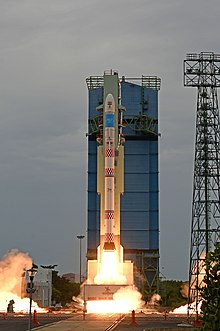SSLV-D1
 SSLV-D1/EOS-02 launches from First Launch Pad | |
| SSLV launch | |
|---|---|
| Launch | 7 August 2022, 03:48 (UTC)[1] |
| Pad | Satish Dhawan Space Centre |
| Payload | |
| SSLV launches | |
The SSLV-D1 was the first mission of the Small Satellite Launch Vehicle (SSLV). Due to a sensor fault during separation of second stage and subsequent initiation of Open Loop Guidance by onboard computer to salvage the mission, the upper stage did not fire for planned duration and payloads were ultimately injected into a decaying orbit not achieving the objectives of mission.
Details[edit]
ISRO developed a small satellite launch vehicle (SSLV) to cater the launch of up to 500 kg satellites to Low Earth Orbits on ‘launch-on-demand’ basis.

SSLV-D1 mission launched EOS 02, a 135 kg satellite, with a planned Low Earth orbit of about 350 km altitude, at an inclination of about 37 degrees. EOS-02 was an Earth observation satellite designed and realised by ISRO. This microsat-type satellite offered advanced optical remote sensing operating in infrared band with high spatial resolution. The bus configuration was derived from IMS-1 bus.
The mission also carried the AzaadiSAT satellite. AzaadiSAT was a 8U Cubesat weighing around 8 kg. It carried 75 different payloads each weighing around 50 grams and conducting femto-experiments. Girl students from rural regions across the country were provided guidance to build these payloads. The payloads were integrated by the student team of “Space Kidz India”. The payloads included a UHF-VHF Transponder working in ham radio frequency to enable voice and data transmission for amateur radio operators, a solid state PIN diode-based Radiation counter to measure the ionising radiation in its orbit, a long-range transponder and a selfie camera. The ground system developed by ‘Space Kidz India’ was to be utilised for receiving the data from this satellite.[3]
Launch[edit]

SSLV launched on its maiden flight at 03:48 UTC / 09:18 IST on 7 August 2022,[1][4] from the First Launch Pad, but failed to reach the intended orbit.[5] Due to an anomaly detected with accelerometers after second stage separation the stage as well as the two satellite payloads were injected into an unstable elliptical orbit measuring 356km × 76km and subsequently destroyed upon reentry. According to the ISRO, the mission software failed to identify and correct a sensor fault and switched to Open Loop Guidance to salvage the mission.[6][7] This led to the VTM stage firing only briefly (0.1s) and payloads were injected to a very low perigee.[8]
References[edit]
- ^ a b https://twitter.com/ISRO/status/1554003107545092096 [bare URL]
- ^ "AzaadiSAT – Space Kidz India". Retrieved 2022-07-08.
- ^ "SSLV-D1/EOS-02 Mission - ISRO". Archived from the original on 2022-08-07. Retrieved 2022-08-05.
- ^ Kumar, Chethan (19 July 2022). "Another Chandrayaan-3 test done on Sunday; SSLV launch planned for August". The Times of India. Retrieved 19 July 2022.
- ^ "ISRO plans to launch new rocket before Dec 2020".
- ^ Indian Space Research Organization [@isro] (August 7, 2022). "SSLV-D1/EOS-02 Mission update: SSLV-D1 placed the satellites into 356 km x 76 km elliptical orbit instead of 356 km circular orbit. Satellites are no longer usable. Issue is reasonably identified. Failure of a logic to identify a sensor failure and go for a salvage action caused the deviation. A committee would analyse and recommend. With the implementation of the recommendations, ISRO will come back soon with SSLV-D2. A detailed statement by Chairman, ISRO will be uploaded soon" (Tweet) – via Twitter.
- ^ Subramanian, T. s (2022-08-11). "ISRO chief S. Somanath interview | 'An anomaly for two seconds led to SSLV mission's underperformance'". The Hindu. ISSN 0971-751X. Retrieved 2022-08-11.
- ^ "ISRO's Maiden Small Satellite Rocket Flight Ends in Doubt After Engine Fails to Fire". The Wire. Retrieved 2022-08-07.
